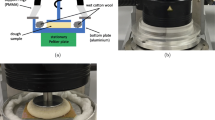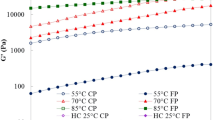Abstract
In this study, the working principles and the theoretical background of a new method to measure the viscoelastic properties of dough in the fermentation process are presented. During measurements, the dough sample was placed between a stationary bottom plate and an oscillating top plate and squeezed at random frequencies ranging from 10 to 100,000 rad/s. By measuring the required force and velocity of oscillations, the mechanical impedance of the samples, defined as the ratio of the force to oscillation velocity, was determined during fermentation. The measured mechanical impedance was used to calculate viscoelastic properties such as elastic and loss moduli of the dough samples. The nondestructive quick measurements and data covering a wide range of frequencies are some of the main advantages of the method. Furthermore, the described instrument can be easily affixed to the commonly available texture analyzer type equipments.








Similar content being viewed by others
References
Weipert D (1990) Cereal chem 67:311–317
Dobraszczyk BJ, Campbell GM, Gan Z (2000) Bread—a unique food. In: Dobraszczyk BJ, Dendy DAV (eds) Cereals and cereal products: technology and chemistry. Aspen, Germantown
Wehrle K, Arendt EK (1998) Cereal Chem 75(6):882–886
Newberry MP, Phan-Thien N, Larroque OR, Tanner RI, Larsen NG (2002) Cereal chem 79:874–879
Salvador A, Sanz T, Fiszman SM (2006) Food Hydrocolloids 20:780–786
Ito M, Yoshikawa S., Asami K, Hanai T (1992) Cereal Chem 60:325–327
Collado M, Deleyn I (2000) Cereal Foods World 45:214–218
Elmehdi HM, Page JH, Scanlon MG (2003) Trans Chem E 81:217–223
Lee S, Pyrak-Nolte L, Campanella HO (2004). J Texture Stud 35:33–51
Ferry JD (1980) Viscoelastic properties of polymers. Wiley, New York
Harris CM, Piersol AG (2002) Harris’ shock and vibration handbook, 5th edn. McGraw-Hill, New York
Field JS, Swain MV, Phan-Thien N (1996) J Non-Newtonian Fluid Mech 65:177–194
Mert B, Sumali H, Campanella OH (2003) Rheol Acta 42:534–538
Mert B, Sumali H, Campanella OH (2004) Rev Sci Instrum 75(8):2613–2619
Oliver G, Brock CJ (1997) J Sci Food Agric 74:294–300
Acknowledgments
The author acknowledges financial support from The Scientific and Technological Research Council of Turkey (TÜBİTAK TOVAG), Project No.: 106 O 298.
Author information
Authors and Affiliations
Corresponding author
Rights and permissions
About this article
Cite this article
Mert, B. A new instrumental setup for determination of small amplitude viscoelastic properties of dough during fermentation. Eur Food Res Technol 227, 151–157 (2008). https://doi.org/10.1007/s00217-007-0704-y
Received:
Revised:
Accepted:
Published:
Issue Date:
DOI: https://doi.org/10.1007/s00217-007-0704-y




